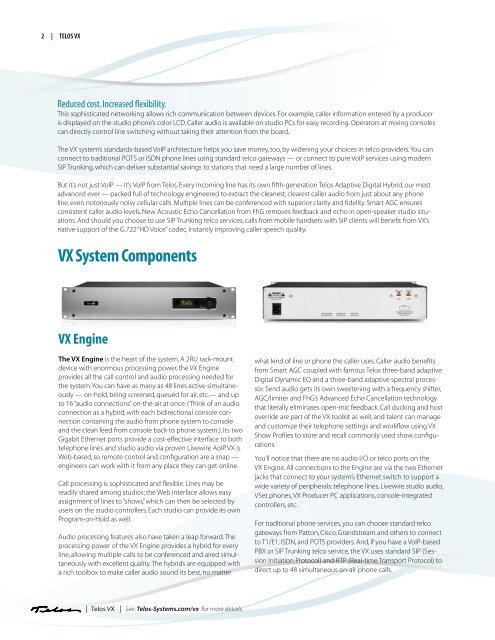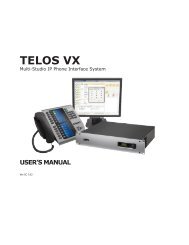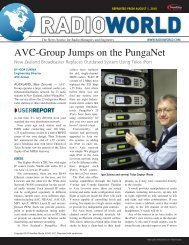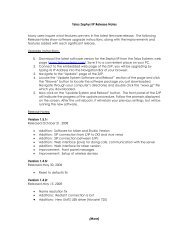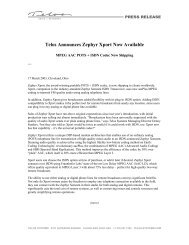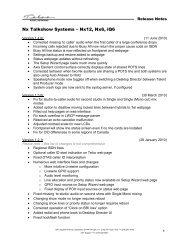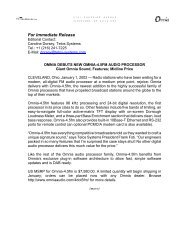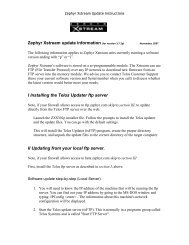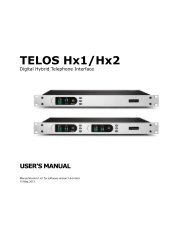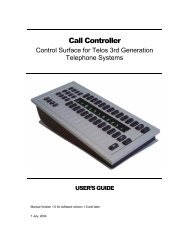Create successful ePaper yourself
Turn your PDF publications into a flip-book with our unique Google optimized e-Paper software.
2 | TELOS<strong>VX</strong><br />
Reduced cost. Increased flexibility.<br />
This sophisticated networking allows rich communication between devices. For example, caller information entered by a producer<br />
is displayed on the studio phone’s color LCD. Caller audio is available on studio PCs for easy recording. Operators at mixing consoles<br />
can directly control line switching without taking their attention from the board.<br />
The <strong>VX</strong> system’s standards-based VoIP architecture helps you save money, too, by widening your choices in telco providers. You can<br />
connect to traditional POTS or ISDN phone lines using standard telco gateways — or connect to pure VoIP services using modern<br />
SIP Trunking, which can deliver substantial savings to stations that need a large number of lines.<br />
But it’s not just VoIP — It’s VoIP from <strong>Telos</strong>. Every incoming line has its own fifth-generation <strong>Telos</strong> Adaptive Digital Hybrid, our most<br />
advanced ever — packed full of technology engineered to extract the cleanest, clearest caller audio from just about any phone<br />
line, even notoriously noisy cellular calls. Multiple lines can be conferenced with superior clarity and fidelity. Smart AGC ensures<br />
consistent caller audio levels. New Acoustic Echo Cancellation from FhG removes feedback and echo in open-speaker studio situations.<br />
And should you choose to use SIP Trunking telco services, calls from mobile handsets with SIP clients will benefit from <strong>VX</strong>’s<br />
native support of the G.722 “HD Voice” codec, instantly improving caller speech quality.<br />
<strong>VX</strong> System Components<br />
<strong>VX</strong> Engine<br />
The <strong>VX</strong> Engine is the heart of the system. A 2RU rack-mount<br />
device with enormous processing power, the <strong>VX</strong> Engine<br />
provides all the call control and audio processing needed for<br />
the system. You can have as many as 48 lines active simultaneously<br />
— on-hold, being screened, queued for air, etc.— and up<br />
to 16 “audio connections” on-the-air at once. (Think of an audio<br />
connection as a hybrid, with each bidirectional console connection<br />
containing the audio from phone system to console<br />
and the clean feed from console back to phone system.). Its two<br />
Gigabit Ethernet ports provide a cost-effective interface to both<br />
telephone lines and studio audio via proven Livewire AoIP. <strong>VX</strong> is<br />
Web-based, so remote control and configuration are a snap —<br />
engineers can work with it from any place they can get online.<br />
Call processing is sophisticated and flexible. Lines may be<br />
readily shared among studios; the Web interface allows easy<br />
assignment of lines to “shows”, which can then be selected by<br />
users on the studio controllers. Each studio can provide its own<br />
Program-on-Hold as well.<br />
Audio processing features also have taken a leap forward. The<br />
processing power of the <strong>VX</strong> Engine provides a hybrid for every<br />
line, allowing multiple calls to be conferenced and aired simultaneously<br />
with excellent quality. The hybrids are equipped with<br />
a rich toolbox to make caller audio sound its best, no matter<br />
| <strong>Telos</strong> <strong>VX</strong> | See <strong>Telos</strong>-Systems.com/vx for more details.<br />
what kind of line or phone the caller uses. Caller audio benefits<br />
from Smart AGC coupled with famous <strong>Telos</strong> three-band adaptive<br />
Digital Dynamic EQ and a three-band adaptive spectral processor.<br />
Send audio gets its own sweetening with a frequency shifter,<br />
AGC/limiter and FhG’s Advanced Echo Cancellation technology<br />
that literally eliminates open-mic feedback. Call ducking and host<br />
override are part of the <strong>VX</strong> toolkit as well, and talent can manage<br />
and customize their telephone settings and workflow using <strong>VX</strong><br />
Show Profiles to store and recall commonly used show configurations.<br />
You’ll notice that there are no audio I/O or telco ports on the<br />
<strong>VX</strong> Engine. All connections to the Engine are via the two Ethernet<br />
jacks that connect to your system’s Ethernet switch to support a<br />
wide variety of peripherals: telephone lines, Livewire studio audio,<br />
VSet phones, <strong>VX</strong> Producer PC applications, console-integrated<br />
controllers, etc.<br />
For traditional phone services, you can choose standard telco<br />
gateways from Patton, Cisco, Grandstream and others to connect<br />
to T1/E1, ISDN, and POTS providers. And, if you have a VoIP-based<br />
PBX or SIP Trunking telco service, the <strong>VX</strong> uses standard SIP (Session<br />
Initiation Protocol) and RTP (Real-time Transport Protocol) to<br />
direct up to 48 simultaneous on-air phone calls.


